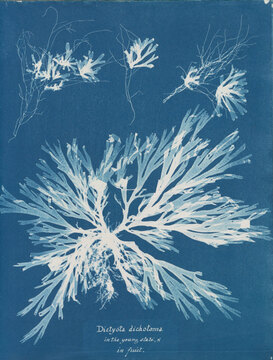 Luminescent, intricate photographic renderings of botanical forms -- "British Algae", otherwise known as seaweed -- appear in light blue and white against a darker blue background. This is the work of Anna Atkins, a long-obscured 19th Century botanist, artist, and pioneer in the application of photography to science. Atkins's work is on display through February 17 at the New York Public Library, Atkins applied the process of cyanotype, a cameraless photographic method utilizing light-sensitive paper to create in 1843 the first book illustrated exclusively with photographs. She donated the book, Photographs of British Algae: Cyanotype Impressions, the Royal Society and dedicated it to her father, John Children, a fellow at the Royal Society. Children was friends with John Herschel, an astronomer and early photographic pioneer, who invented cyanotype in 1842 and introduced Atkins to the photographic medium. Atkins's application of photography to capture botanical images was a leap forward for scientific advancement. As noted in the NYPL exhibit: "In Renaissance Europe, artists' renditions exploded in popularity as the need arose for repeatable visual information to complement the printed word. The marked rise in the level of scientific inquiry from the 17th century forward paralleled a growing sophistication n these drawings and improved methods of distributing them. Among the most socially useful applications of art and science was the herbal, a genre of reference book on plants that describes their appearance as well as their medicinal, culinary or toxic properties. The hand of the artist, however, was not always in sync with the eye of the scientist, Rare was the individual who could reconcile the two. Difficulty emerged when the artist could not comprehend- or perhaps wasn't sympathetic to--the kind of information of greatest value to the botanist. Before British Algae, the only pictorial catalogues of botanical collections were illustrations with hand-rendered artists' impressions, or sometimes with actual dried plants affixed to their pages." The NYPL exhibit, the first dedicated to a full representation of Atkins's productions, not only offers insights into the history of photography and its application to science by a daring and innovative female scientist of the Victorian era, when gender roles usually relegated women to the domestic sphere. It also depicts flora in stunning detail and in ways that highly their exquisite beauty and symmetry. If cold weather is giving you the blues, step inside the NYPL to discover nature's blue prints.
1 Comment
|
About this Blog
Hi! I'm Nancy Kopans, founder of Urban Edge Forest Therapy. Join me on an adventure to discover creative ways to connect with nature in your daily life, ways that are inspired by urban surroundings that can reveal unexpected beauty, with the potential to ignite a sense of wonder. Archives
April 2023
Categories
All
|

 RSS Feed
RSS Feed